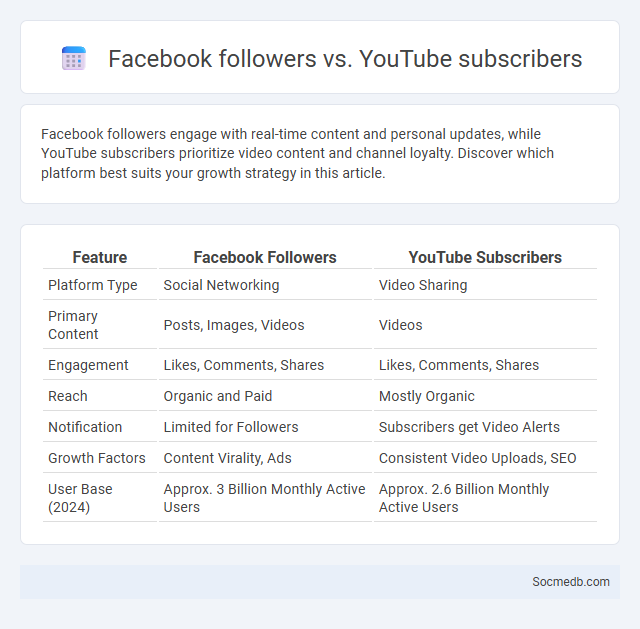
Photo illustration: Facebook Followers vs YouTube Subscribers
Facebook followers engage with real-time content and personal updates, while YouTube subscribers prioritize video content and channel loyalty. Discover which platform best suits your growth strategy in this article.
Table of Comparison
| Feature | Facebook Followers | YouTube Subscribers |
|---|---|---|
| Platform Type | Social Networking | Video Sharing |
| Primary Content | Posts, Images, Videos | Videos |
| Engagement | Likes, Comments, Shares | Likes, Comments, Shares |
| Reach | Organic and Paid | Mostly Organic |
| Notification | Limited for Followers | Subscribers get Video Alerts |
| Growth Factors | Content Virality, Ads | Consistent Video Uploads, SEO |
| User Base (2024) | Approx. 3 Billion Monthly Active Users | Approx. 2.6 Billion Monthly Active Users |
Overview: Defining Facebook Followers, YouTube Subscribers, and Followers
Facebook followers represent users who have chosen to receive updates and posts from a specific page, reflecting ongoing interest and engagement with the content shared. YouTube subscribers are individuals who actively subscribe to a channel to access regular video content, playing a crucial role in a channel's visibility and growth within the platform's algorithm. Followers, in a broader social media context, indicate users who opt to receive updates from an account, signifying their support and interest across various platforms.
Platform Engagement: Interacting with Facebook, YouTube, and Other Followers
Maximizing platform engagement involves actively interacting with followers on Facebook and YouTube by responding to comments, hosting live sessions, and creating shareable content. Utilizing Facebook Groups and YouTube Community features fosters a loyal audience and encourages meaningful conversations. Analyzing engagement metrics such as likes, shares, and watch time helps refine strategies to enhance follower interaction across social media platforms.
Content Visibility: How Algorithms Treat Followers and Subscribers
Social media algorithms prioritize content based on user engagement, meaning your posts are more likely to appear in followers' feeds if they interact frequently through likes, comments, or shares. Subscribers who actively follow and engage with your content receive higher visibility, while passive followers may see fewer updates from you. Understanding these algorithmic behaviors helps you tailor your strategy to boost content reach and maintain consistent audience interaction.
Audience Growth: Strategies for Increasing Followers and Subscribers
Effective audience growth on social media requires consistent content creation tailored to your target demographics, leveraging data analytics to optimize posting times and formats for maximum engagement. Utilizing platform-specific features such as Instagram Reels, YouTube Shorts, or Twitter Spaces can significantly boost visibility and attract new followers. Collaborations with influencers and active community engagement foster trust and expand reach, directly increasing your follower and subscriber counts.
Reach and Impressions: Facebook vs YouTube Analytics
Analyzing Reach and Impressions on Facebook and YouTube Analytics reveals distinct patterns due to platform algorithms and content formats. Facebook provides detailed metrics on active users reached through posts and ads, helping you optimize audience engagement effectively. YouTube focuses on video impressions and watch time, crucial for understanding viewer retention and expanding channel visibility.
Monetization Potential: Earning with Followers and Subscribers
Monetization potential on social media platforms hinges on your ability to engage and grow followers and subscribers through quality content and consistent interaction. You can generate revenue via sponsored posts, affiliate marketing, ad revenue sharing, and exclusive subscriber content on platforms like Instagram, YouTube, and Patreon. Leveraging analytics to understand audience preferences maximizes earning opportunities and long-term financial sustainability.
Community Building: Differences in Platform Interactions
Social media platforms vary significantly in community building, with Facebook fostering in-depth group discussions and LinkedIn emphasizing professional networking and knowledge-sharing. Instagram encourages visual storytelling and influencer engagement to build niche communities, while Twitter enables real-time conversations and hashtag-driven movements for broader reach. TikTok's short-form video format cultivates highly interactive and rapidly growing communities centered around trends and challenges.
Platform Demographics: Who Follows and Subscribes Where?
Different social media platforms attract distinct demographics, with Instagram primarily engaging younger audiences aged 18-34, while Facebook maintains a broader user base across age groups, including a significant number of users over 45. LinkedIn is favored by professionals and B2B audiences, making it ideal for career networking and industry content, whereas TikTok appeals to Gen Z with its short-form, viral video content. Understanding where your target audience subscribes or follows helps tailor your marketing strategy to maximize engagement and reach.
Brand Value: Impact of Followers and Subscribers on Credibility
A substantial number of social media followers and subscribers significantly enhances brand value by boosting perceived credibility and trustworthiness among target audiences. High follower counts serve as social proof, influencing consumer decisions and increasing engagement rates across platforms such as Instagram, YouTube, and Twitter. Brands with strong social media presence often experience improved brand loyalty, higher conversion rates, and greater competitive advantage in digital marketing.
Choosing the Right Audience: Facebook Followers vs YouTube Subscribers
Selecting the right audience depends on platform-specific engagement patterns, with Facebook followers often exhibiting higher interaction rates through comments and shares, while YouTube subscribers provide more sustained attention via video watch time and repeat views. Facebook's demographic skews toward diverse age groups with localized content preferences, whereas YouTube subscribers tend to engage deeply with niche content and longer-form videos. Marketers should analyze metrics such as follower demographics, engagement rates, and content consumption behaviors to align campaign goals with the appropriate audience on each platform.
 socmedb.com
socmedb.com